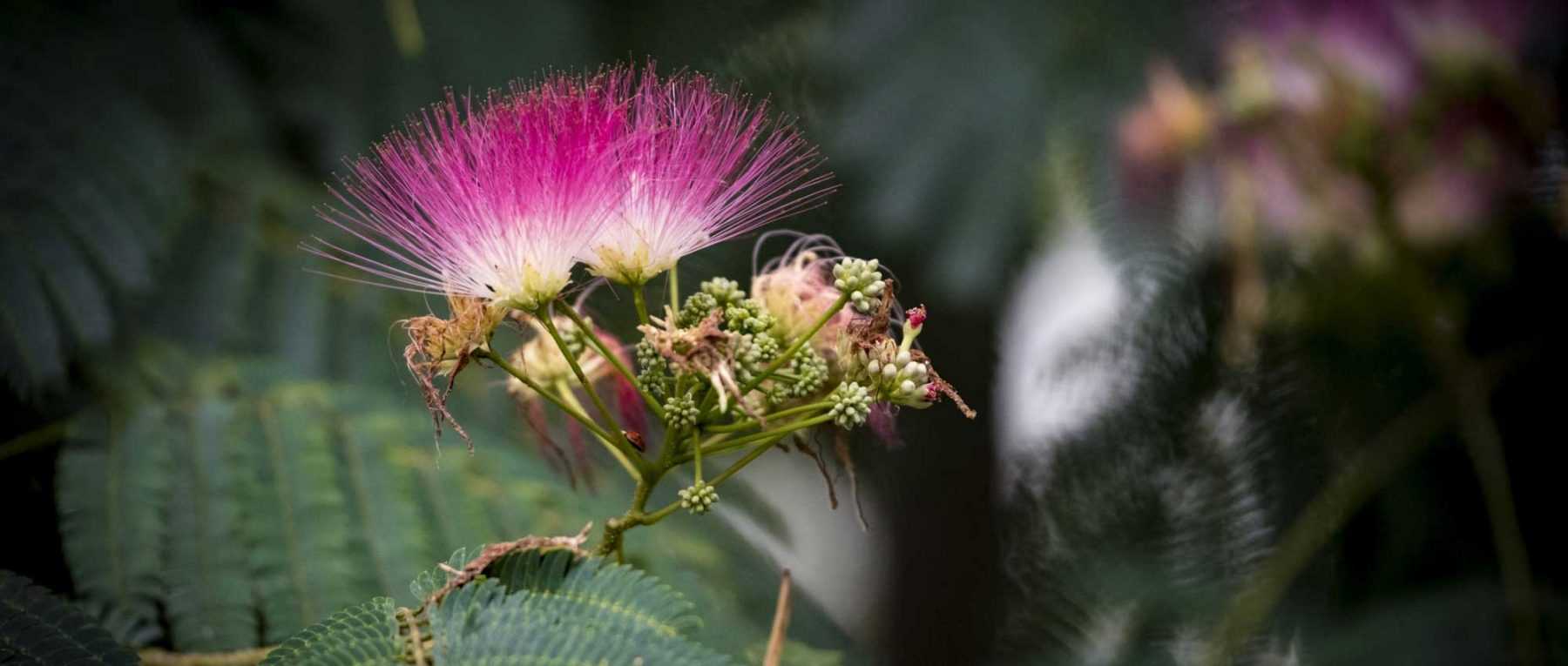
The Albizia: Planting, Pruning and Care
Contents
The Albizia in a nutshell
- The Albizia boasts unique, silky pinkish-white flower plumes
- Drought and salt-tolerant, it thrives in poor soils and is relatively easy to grow
- This sun-loving plant requires a warm position
- With its exotic appeal, it brings a holiday vibe to your garden!
- It’s prized for its beautifully divided, extremely fine foliage
- The perfect shade tree!
Our Expert's Word
Also known as the Silk Tree or Persian Silk Tree, Albizia julibrissin is a deciduous tree with finely divided foliage and silky flowers. The blooms consist of numerous long, pinkish-white stamens, forming fluffy, feathery pom-poms. They stand out beautifully against the soft green foliage. Additionally, the Albizia’s flowers are fragrant and attract pollinators!
Discover the stunning variety Albizia julibrissin ‘Ombrella’, which boasts lovely green leaves and pink flowers. There are also varieties with dark, purple-tinged foliage, such as ‘Summer Chocolate’—an unusual and richly nuanced shade!
The Albizia is prized for its elegant, spreading silhouette, which provides dappled shade. We recommend planting it in spring, preferably as a standalone specimen. Once established in the garden, it is easy to grow and requires minimal maintenance. If you wish to prune it for a more balanced shape, do so in late winter or early spring. This tree thrives in warmth—perfect for southern gardens, it will flourish in full sun and well-drained, even slightly sandy soil.
Botany
Botanical data
- Latin name Albizia julibrissin
- Family Fabaceae
- Common name Silk Tree, Persian Silk Tree
- Flowering summer
- Height typically up to 6 metres
- Exposure full sun
- Soil type well-drained
- Hardiness between -5 and -15°C, depending on variety and plant age
Albizias are deciduous trees and shrubs prized for their silky inflorescences and finely divided foliage, as delicate as mimosa! The most commonly cultivated species is Albizia julibrissin. It is believed to originate from Persia (Iran) and Asia (Asia Minor, the Himalayas, Bhutan, China, Japan…). It has naturalised in several regions worldwide and has become an invasive plant in the United States. The Albizia genus comprises between 140 and 150 species native to Africa, Australia and Asia. They are found in tropical and subtropical regions, which explains why Albizia thrives in warm conditions and is only moderately hardy.
It was named Albizia in honour of Filipo degli Albizzi, a naturalist who brought the plant to Europe in the 18th century. Its species name, julibrissin, is thought to derive from Persian, meaning “silk flower” – an idea reflected in its common name of Silk Tree, alluding to its silky, very soft flowers. In French, it is also called Mimosa of Constantinople, and indeed it is very closely related to Mimosa. As for its scientific name, it is sometimes classified under the genus Paraserianthes (synonym).
Albizia belongs to the Fabaceae family, along with beans, peas, wisteria, clover and lupins… This is one of the most economically important plant families as it includes many food crops. These plants have the particularity of not requiring nitrogen fertilisers, as their roots, in association with bacteria, can fix atmospheric nitrogen. Albizia belongs to the Mimosoideae subfamily: it is very closely related to Mimosas and Acacias.
Albizia typically reaches between six and ten metres in height, but can grow up to 15 metres tall under optimal conditions. Albizia has superb architecture: it develops a rather spreading form with very horizontal branches, allowing it to reach 5 to 6 metres in width. With its flattened crown, it has a true parasol shape… making it a perfect shade tree! Its bark is grey and smooth, forming vertical striations as the tree ages.
Albizia flowers in midsummer, from mid-June to early July, continuing through August-September. It then produces an original flowering display, with plume-like or pom-pom blooms clustered in terminal racemes. Each flower is borne on a long peduncle (flower stalk) and measures between two and four centimetres in diameter. The flowers have very short, fused sepals and petals with five lobes. It’s the stamens that are most impressive – very long and numerous. They measure between two and four centimetres in length, giving that very soft appearance which earns the plant its nickname of Silk Tree. They are white at the base and bright pink at the tips, creating an original, luminous gradient. The flowers are hermaphroditic (bearing both male and female organs: stamens and pistil). Depending on the species, the inflorescence shape may vary. For example, in Albizia lophantha, it takes on a “bottlebrush” form.
The flowers of Albizia julibrissin form white and bright pink pom-poms that stand out beautifully against the green foliage. They resemble calliandra flowers. Depending on the species and variety, the flowers may also be entirely white, as in Albizia julibrissin ‘Alba’, or cream-white as in Albizia amara, or even yellow-green. Sometimes they take on a very vivid, almost red hue, as in Albizia ‘Rouge de Tuilière’. When white or cream, Albizia flowers have a very light and delicate appearance.
Albizia flowers are fragrant! They produce nectar and are melliferous: they attract bees and butterflies.
As Albizia is very closely related to Mimosas and Acacias, it also boasts very beautiful foliage that closely resembles theirs. Its foliage is light, not very dense, providing dappled shade that shelters from the sun while allowing good light penetration. Albizia is a deciduous tree, losing its leaves in autumn and producing new ones in spring. The leaves of Albizia julibrissin can grow up to 45 centimetres long and 25 centimetres wide. They are alternate, arranged one after another along the branches.
Albizia foliage is extremely decorative. The leaves are twice-divided: they split into leaflets, which are themselves divided into leaflet segments… creating very small segments that make the foliage particularly light and feathery! Its very fine leaves somewhat resemble fern foliage. They often consist of 8 to 12 pairs of leaflets, each subdivided into 20 to 50 leaflet segments. The number of leaflets and leaflet segments may vary by variety, but is always even-numbered: they are described as paripinnate. The leaflet segments are oblong and measure up to one centimetre in length.
The leaves have a beautiful colour, a tender yet deep green. The Albizia ‘Summer Chocolate’ stands out for its very dark, purple-brown foliage. Its young leaves are initially green, then darken with time. This variety offers slightly less interesting flowering than the Albizia ‘Ombrella’, but is spectacular for its foliage!


Albizia foliage: detail of an Albizia julibrissin leaf / the purple foliage of Albizia ‘Summer Chocolate’ / Albizia julibrissin (photo by Jean-Pol GRANDMONT)
The leaflets have the particularity of being able to move: they fold up at night and when light levels are low. We must remember that Albizia is very closely related to Mimosa, including Mimosa pudica, the sensitive plant known for quickly folding its leaves when touched… Fabaceae plants can easily fold their leaflets!
Albizia roots, like those of other Fabaceae, have the ability to fix atmospheric nitrogen by associating with bacteria of the Rhizobium genus. The roots form nodules that allow the bacteria to live in symbiosis with the plant, providing nitrogen in exchange for carbon compounds from photosynthesis.
From September-October, Albizia produces long, flattened pods, initially green then turning brown. They measure between 10 and 20 centimetres in length and contain between five and fifteen oval, dark brown seeds. Albizia may self-seed spontaneously. You can harvest the seeds and store them for spring sowing.


Detail of Albizia julibrissin pods (photo by Ninjatacoshell) / Pods still on the tree / Seeds contained in the pods (photo by Ninjatacoshell)
Albizia is not extremely hardy. It can withstand -10°C, even -15°C for short periods if the cold doesn’t persist. Young plants are more sensitive to cold and may need winter protection. Albizia is a relatively fast-growing tree, especially in warm, sunny climates, but it doesn’t live very long, rarely exceeding 25 or 30 years.
What are the main varieties of Albizia?
The Most Popular Varieties
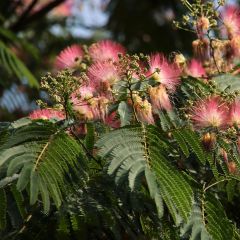
Albizia julibrissin Ombrella
- Blütezeit August, September
- Höhe bei Reife 5 m
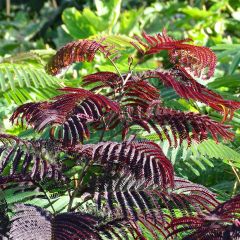
Albizzia julibrissin Summer Chocolate
- Blütezeit August, September
- Höhe bei Reife 4,50 m
When to plant Albizia?
Where to plant?
It is best to grow the Albizia in a mild climate. It will thrive in gardens in the south of France! During the first few years, it is relatively sensitive to cold. Once mature, it copes better with cold winters and can tolerate temperatures between -10 and -15°C. In any case, plant it in full sun, in a warm, well-exposed position. Choose a spot sheltered from cold winds. The Albizia ‘Summer Chocolate’ appears slightly more delicate and challenging to grow than the ‘Ombrella’ variety.
The Albizia is a low-maintenance plant that tolerates poor soils. It thrives in well-draining, preferably sandy soil. Avoid planting it in clay soil. It really dislikes waterlogged conditions and overly compact soils. Don’t hesitate to add drainage materials during planting: pumice, gravel, etc.
The Albizia tolerates salty soils quite well—it will adapt easily if your garden is near the sea. It also copes with chalky soils.
Since the Albizia can grow quite large, it’s best not to plant it too close to a house or terrace. Its roots spread and sometimes produce suckers, which could damage buildings. In any case, give it enough space to develop its canopy freely without requiring severe pruning.
If you live in a region with harsh winters, consider planting the Albizia in a container (at least for the first few years) and bringing it into a greenhouse over winter. Choose a large pot and add a drainage layer at the bottom. Plant the tree and water it. You may eventually transplant it into the ground after a few years.
When to plant?
Plant the Albizia preferably in spring, outside of frost periods.
How to plant the Albizia?
We generally recommend planting the Albizia as a standalone specimen to showcase it better. However, if planting multiple trees, leave at least seven metres between them.
- Soak the root ball in a bucket of water. This will help the plant establish more easily.
- Dig a planting hole, two to three times the size of the root ball (at least 80 cm wide and deep). Feel free to add gravel or pumice to improve drainage.
- Remove the plant from its pot and gently loosen the roots.
- Position your Albizia. The top of the root ball should be level with the ground.
- Insert a stake to keep the trunk upright.
- Backfill with soil and firm it down.
- Water generously.
We advise watering regularly in the weeks following planting.
How to care for the Albizia?
The Albizia is drought-resistant. It’s best to water it during the first year after planting, but once mature, it will manage perfectly well without watering. In the early years, the tree is still fragile, which is why we recommend protecting it in winter with horticultural fleece. You can also add mulch around the base of the tree: this will provide extra protection against the cold and help retain soil moisture. The Albizia adapts well to poor soils and has fairly low fertiliser or compost requirements. However, you can apply a small amount at the beginning of spring to encourage flowering.
Pruning the Albizia isn’t strictly necessary. If you do wish to prune it, follow our advice: Albizia: When and How to Prune It? For an older tree, read our article How to Revitalise an Old Albizia or Silk Tree.
In terms of diseases, the Albizia can be affected by fusarium wilt, caused by a fungus. The leaves wilt and discolour but tend to remain on the tree. Like many fungal diseases, it thrives in warm, humid conditions. Unfortunately, there is no treatment. Cut off and burn affected branches to prevent its spread.
The Albizia can sometimes be affected by coral spot disease. The bark becomes deformed and cracks, with orange pustules appearing on the trunk and branches. If your tree is severely affected, we recommend felling it to prevent the disease from spreading to other plants. Otherwise, prune and burn the affected branches, apply a wound sealant, then spray with a fungicide (Bordeaux mixture, sulphur, etc.). Feel free to consult our advice sheet: How to Prevent Coral Spot Disease?
Also, beware of canker. This is caused by fungi or bacteria attacking the wood: branches dry out, bark splits, and swellings appear on the trunk or branches… We recommend removing damaged parts and applying a fungicide (Bordeaux mixture, sulphur, etc.). As a preventive measure, ensure clean pruning cuts with sterilised tools and apply wound sealant to avoid canker.
Psyllids may attack the Albizia. These are insects that pierce the foliage and secrete honeydew, which may drip beneath the tree, staining anything below (cars, garden furniture, etc.). Sometimes, scale insects target the Albizia. The honeydew secreted by psyllids or scale insects can lead to sooty mould (a black fungal coating on the foliage). To combat psyllids and scale insects, you can treat by spraying the foliage with black soap. When grown in a greenhouse, the Albizia may also be attacked by red spider mites.
How to propagate Albizia?
To propagate Albizia, we recommend sowing seeds, which is easier to succeed with than cuttings or grafting.
Sowing Albizia
Prefer sowing seeds of the botanical species Albizia julibrissin rather than cultivars like ‘Ombrella’ or ‘Summer Chocolate’, as these may produce seedlings that differ from the original variety. You can sow in late winter or early spring.
- If you already have an Albizia in your garden, collect seeds from the tree’s pods once they turn brown and dry. Otherwise, you can order them.
- Store the seeds in a cool, dry place until early spring.
- Before sowing, soak the seeds in warm water for at least 24 hours. This softens the seed coat. You can also scarify them to aid germination by nicking the coat with a knife or sandpaper.
- Fill pots with a mix of compost and sand, then water.
- Sow the seeds, cover with a layer of compost (2-3 cm deep), and lightly firm.
- Place them in a warm, sheltered spot (at least 18°C) with good light.
- Keep the substrate moist until germination. Water regularly.
- Transplant into individual pots once large enough to handle. Grow under cover in the first year and plant out the following spring.
Albizia sometimes self-seeds, and you may find young seedlings at the base of the tree. Simply lift and transplant them.
Taking Albizia Cuttings
In midsummer, you can take semi-hardwood cuttings. Propagating Albizia from cuttings is trickier than sowing but ensures faithful reproduction of horticultural varieties.
- Prepare a pot with compost.
- Take a cutting at least 10 cm long, cutting just below a node (where leaves join the stem). Avoid flowering stems. Remove lower leaves, keeping only a few at the top.
- Optionally dip the base in rooting hormone.
- Insert into the compost and firm around the stem.
- We recommend covering the pot with a plastic bag to maintain humidity.
- Place in a sheltered, bright spot without direct sun.
- Open the bag regularly to ventilate and prevent fungal growth.
- Water when the compost begins to dry.
Root cuttings are also possible in winter, around February. Gently uncover soil near the tree to collect roots (2-3 cm thick). Cut into 10 cm sections. Plant in pots filled with compost and water.
→ Learn more in our tutorial Taking Albizia Cuttings
Grafting Albizia
You can graft Albizia in summer using bud grafting. Water both rootstock and scion a few days beforehand.
- Cut a branch from the desired variety.
- Select a well-formed bud, carefully slicing under the bark (avoiding the woody core).
- Make a T-shaped cut on the rootstock, gently parting the bark.
- Insert the bud shield, trimming excess bark if needed.
- Bind the graft, leaving the bud exposed. It should sprout the following spring.
How to pair Albizia?
The Albizia is ideal when planted as a standalone feature. It boasts a magnificent silhouette, with horizontally growing branches that give it a very spreading habit. We recommend placing it in the middle of a lawn, possibly with garden furniture beneath (bench, table, sun lounger…), to enjoy a moment of relaxation under dappled shade.
You can also plant it in a row. If planted along a pathway, it will provide beautiful shade while adding a majestic touch. Consider alternating Albizia varieties, for example by combining pink-flowered varieties with white-flowered ones… Or by pairing the green foliage of Albizia ‘Ombrella’ with the purple foliage of the ‘Summer Chocolate’ variety. This will create a lovely contrast effect.
For companion planting with Albizia, we recommend choosing other plants in similar tones. Opt for large, divided foliage like wisteria or ferns to create a lush-looking garden. Also consider pink or mauve-flowering plants: Gaura lindheimeri, oleander, Lagerstroemia indica…
For an exotic effect, Albizia can also be paired with other tropical-style plants. Choose for example castor oil plants, Trachycarpus palms or Phormium. In all cases, select plants that thrive in hot, dry conditions. You can create a Mediterranean-inspired garden by planting lavenders, Jerusalem Sage (Phlomis fruticosa), cotton lavenders or Gaura lindheimeri (its flowering will complement the Albizia!). Also consider climbers, which you can train over a pergola or against a wall: trumpet vine, wisteria, grapevine and bougainvillea. Create a dry garden with lush, cooling foliage and colourful blooms.


Albizia can find its place in an exotic-style garden! Albizia julibrissin ‘Ombrella’ (photo wlcutler), Trachycarpus fortunei, Nerium oleander (photo Tubifex), Campsis radicans (photo Dinesh Valke)
→ Discover more companion planting ideas with Albizia in our advice sheet!
Did you know?
- Uses
Albizia wood can be used in joinery and cabinetmaking. Its bark is used in Chinese medicine for its diuretic, digestive and anti-inflammatory properties. The flowers can also help treat depression, insomnia and anxiety.
Useful resources
- Discover our range of Albizia varieties
- Get inspired by this exotic atmosphere for Albizia pairings
- Read our guide on Albizia diseases and pests
- Our video tutorial: How to stake a tree
- Guide – How to prevent coral spot disease
- Guide: trees that thrive in full south-facing positions
- Guide: umbrella-shaped trees
- Our Albizia guides:
- Our tutorials:
Frequently asked questions
-
The leaves of my Albizia are covered in a sticky substance. What should I do?
This is the honeydew secreted by psyllids, small insects that pierce the leaves to extract sap. You may also notice sooty mould developing on the foliage (a black substance on the leaves caused by a fungus). We recommend treating with black soap or pyrethrum.
-
The leaves of my Albizia have turned black. Why?
They are likely covered in sooty mould, a fungus that develops on the honeydew secreted by psyllids or scale insects. There is no real danger to the plant, but it is nevertheless weakened, and its photosynthesis is limited. Treat against scale insects or psyllids using black soap.
-
The bark of my Albizia is cracking, peeling, and the branches are drying out... What should I do?
Your tree is likely affected by coral spot disease. It can also be identified by the presence of orange pustules on the bark. Cut away the affected parts and dispose of them by burning. If the tree is severely infected, consider felling it to prevent the disease from spreading to your other plants. Feel free to consult our advice sheet: How to prevent coral spot disease?
If the bark is damaged and you notice swelling on the trunk or branches, it's probably canker, a disease caused by bacteria or fungi that attacks the wood. Prune the affected branches and apply Bordeaux mixture or sulphur. As a preventive measure, to avoid both coral spot disease and canker, it's important to make clean, precise cuts with disinfected tools and then apply pruning sealant.
-
The leaves are wilting and turning yellow!
Your albizia is affected by fusarium wilt, a fungal disease causing the leaves to yellow, which usually remain attached to the branches. Unfortunately, there is no treatment for this disease. We recommend cutting and burning the affected branches.
If the leaves wilt and fall, it could also be due to a lack of water, especially if you've recently planted it. However, overall, the Albizia is quite a resilient plant: unless planted within the year or during prolonged drought, it can generally manage without additional watering.
- Subscribe!
- Contents
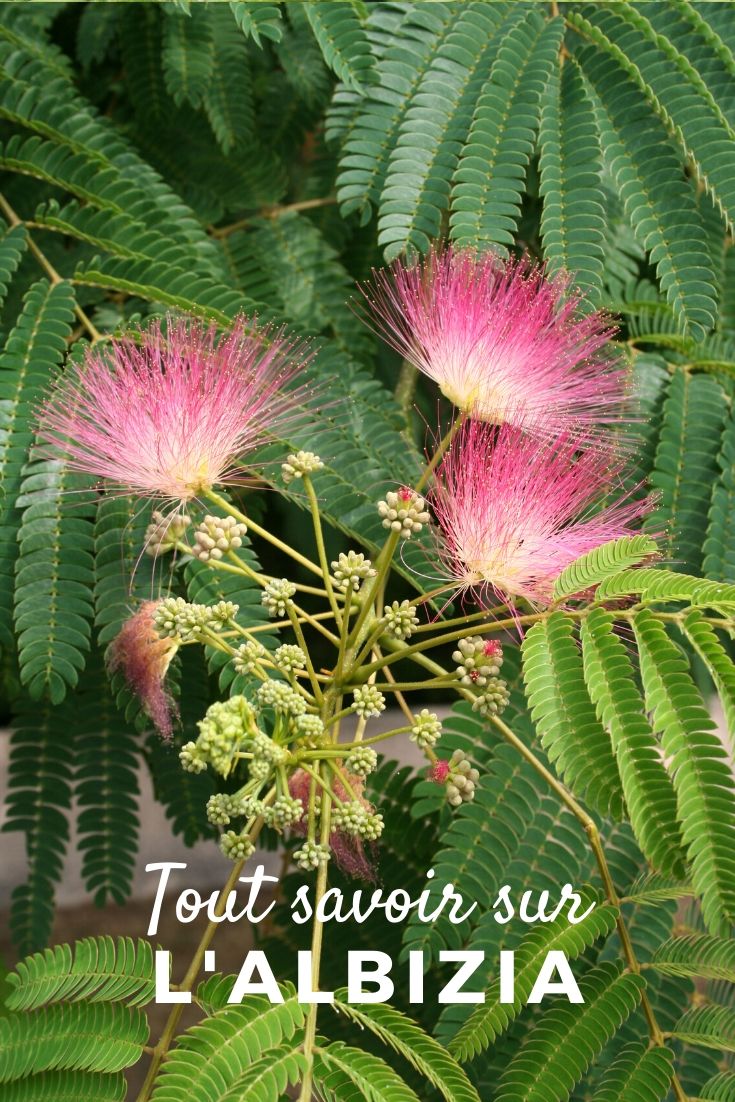


































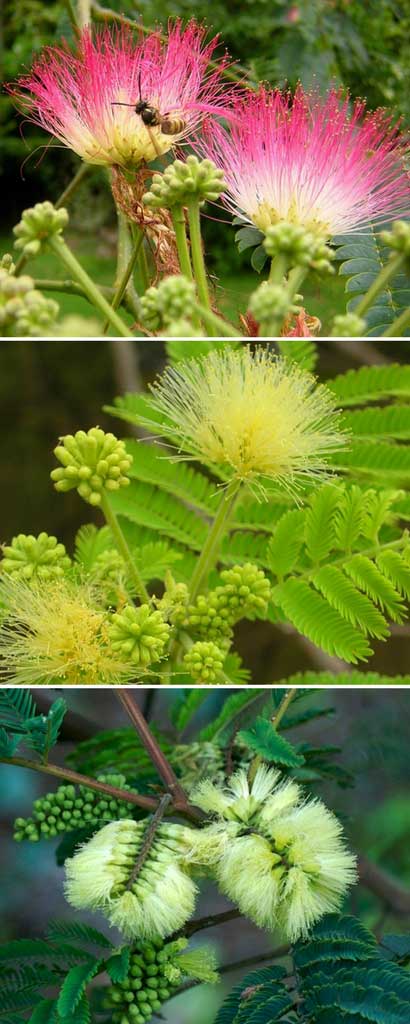
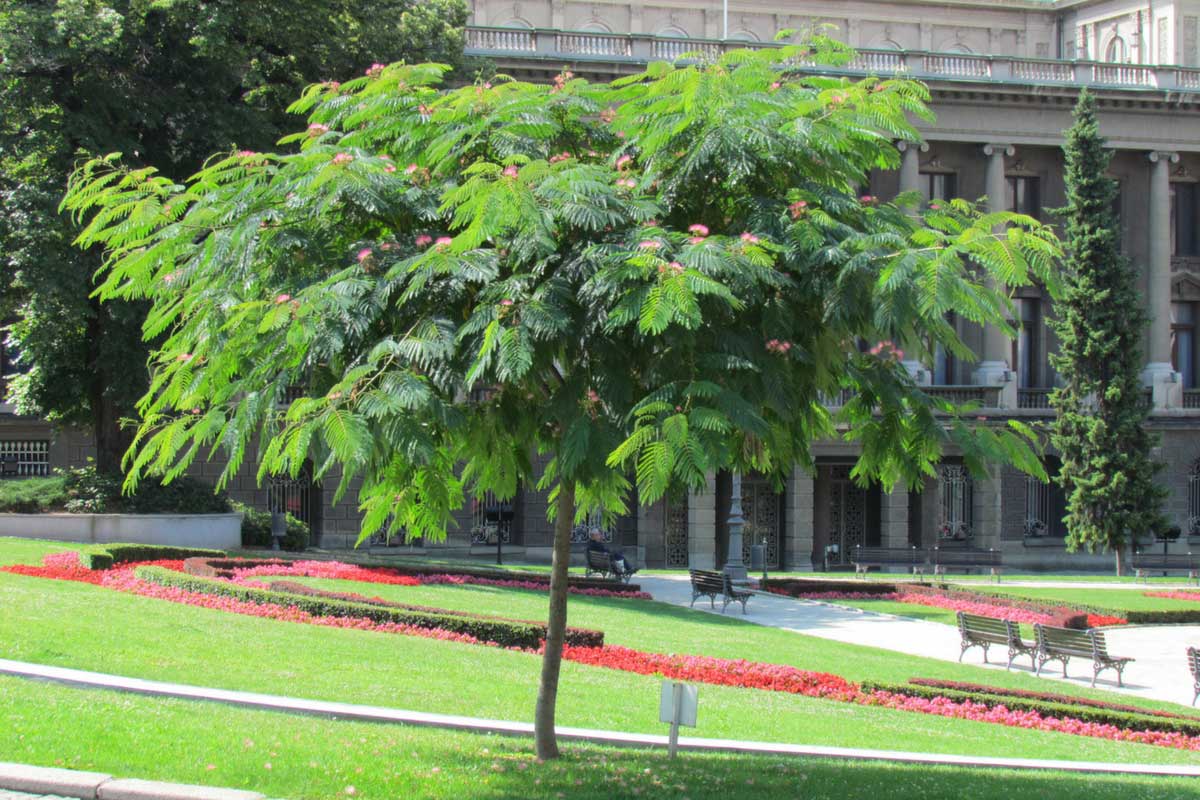

Comments